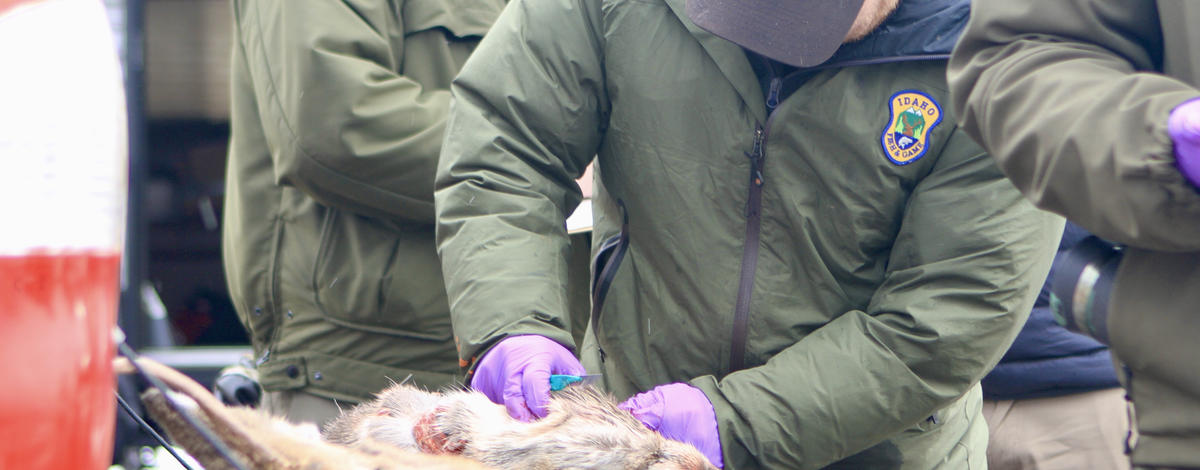Hunters and other interested parties can comment on proposed changes to the 2022 deer and elk seasons from Feb. 22 through March 13. Proposals are in response to the first-ever detection of Chronic Wasting Disease in Unit 14, as well as a recurrence of another disease that unexpectedly reduced whitetails herds in Clearwater Region. The commission is scheduled to decide on changes at its March 23-24 meeting at 600 S. Walnut St. in Boise.
Most hunt changes are prompted by CWD detection
Fish and Game officials discovered six cases of CWD in deer and elk in Unit 14, and wildlife managers are proposing hunt changes there to slow, the spread of CWD. The goal is to keep the prevalence low, which is the number of animals within herds that have the disease, and prevent, or slow, its spread into other areas.
Fish and Game’s 2021 CWD testing showed the amount of disease – or prevalence – is estimated to be less than 2 percent for deer and likely less in elk. Research from others states has shown that keeping the prevalence rate less than 5 percent can slow its spread, but when CWD prevalence rates increase above 5 percent, the disease is more likely to rapidly spread within a herd and also expand geographically.
“Structuring hunts to achieve lower densities of deer, and younger age classes within herds, has also shown to slow the geographic spread of CWD and hold prevalence at current levels or lower,” Fish and Game State Game Manager Rick Ward said.
Proposed hunt change options
Increase mule deer harvest in Unit 14
Option 1: Increase antlered mule deer controlled hunt tags from 180 to 400 tags with the hunting season running from Oct. 10 – Nov. 20.
Option 2: Replace existing antlered controlled hunt (180 tags) with a general-season, antlered-only hunt from Oct. 10 – Nov. 20.
Add antlerless mule deer hunt in Unit 14
Add new mule deer extra antlerless hunt with 200 tags from Oct. 10 – Nov. 20. “Extra tags” allow hunters to harvest an additional animal in addition to a regular or controlled hunt tag.
Add White-tailed deer extra tags in Unit 14
Option 1: In addition to the existing general season, either-sex whitetail hunt, add a new extra antlerless whitetail hunt with 250 tags, and a new whitetail, extra antlered tag with 250 tags. Each hunt would run Oct. 10 – Nov. 20.
Option 2: Extend the existing general, either-sex hunt from Oct. 10 – Dec. 31.
Increase elk tags
Increase elk tags in one land owner permission hunt in Controlled Hunt Unit 14-1 from 50 tags to 80 tags and extend the southern boundary of the hunt unit about 3 miles.
Here's more about proposed changes to manage for CWD:
Epizootic Hemorrhagic Disease hit white-tailed deer herds in 2021
During the summer of 2021, the white-tailed deer in the Clearwater Region experienced an outbreak of Epizootic Hemorrhagic Disease (EHD) primarily in Hunt Units 8, 8A, 10A, 11, 11A, 14 and 16. EHD differs from CWD, and EHD periodically occurs in Central and North Idaho during hot, dry summers and can quickly kill large numbers of deer.
After reviewing harvest data and previous changes to hunting seasons in response to EHD outbreaks in 2003 and 2015, big game managers are recommending eliminating 1,500 deer tags in five “Extra Antlerless Deer Hunts” in the following Controlled Hunt Units:
- 8-1X (Youth), (200 tags in 2021)
- 8-2X, (350 tags in 2021)
- 8A-1X, (350 tags in 2021)
- 10A-1X, (300 tags in 2021)
- 11A-1X. (300 tags in 2021)
Big game managers said it is likely that white-tailed deer numbers will rebound within 3 years in these units, especially with the availability of high-quality habitat and increased carry capacity from herds thinned by EHD.
“Eliminating extra antlerless tags could prove important in allowing the white-tailed deer populations to recover quicker by reducing harvest on an already reduced deer herd,” Fish and Game Deer/elk Coordinator Toby Boudreau said.
People can comment on the proposals on the public comment webpage.
Fish and Game will continue testing for CWD and managing the disease
Now that CWD is known to occur in the state, wildlife managers will ramp up testing. Hunters in Unit 14 and surrounding units are encouraged to have their animals tested for CWD, and Fish and Game will work with them in 2022 to make it more convenient to get animals tested.
Statewide, Fish and Game tested more than 2,500 animals for CWD in 2021. Fish and Game has been testing for the disease since 1997 and sampled more than 20,000 animals during that time.
CWD is a neurological disease that affects deer, elk, moose and caribou. There is no practical live test for the disease, so only samples taken from dead animals can be used. Although new to Idaho, CWD is found in 29 U.S. states and four Canadian provinces, including neighboring states Montana, Wyoming and Utah. Learn more about CWD in Idaho at idfg.idaho.gov/cwd.
CWD affects the nervous system in deer, elk, moose and caribou and is caused by abnormal, misfolded proteins called prions that accumulate within the spinal column and brain, causing progressive damage to those cells and brain damage. CWD has a very long incubation period (time between infection and observable disease) that typically takes at least 10 months for a deer or elk to show signs of illness.

